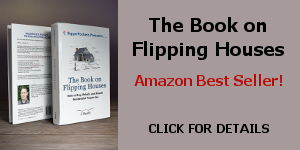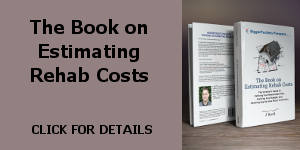Cash Flow Analysis for SFHs
In a previous article, I discussed the two major investing philosophies among SFH investors: Cash Flow vs Appreciation.
As I mentioned at the end of that post, I tend to focus on the cash flow side of the investment, and hope that appreciation takes care of itself in the long run. So, that said, I wanted to provide a quick primer on how to determine if a house you are considering buying will cash flow, and to what extent. While I’ve already created a longer version of this for apartment buildings and other multi-unit properties, this post will be specifically relevant to single family houses…
For this primer, let’s assume we have found a house that we are considering buying to use as a rental, and are performing a cash flow analysis on it. Here’s the step-by-step process for doing so…
Step #1: Identify Income
In most cases, the total income your property is going to produce will come from the rent you are collecting. In some cases, you may also see income from things like providing storage space to tenants, charging for parking spaces, renting furniture to tenants, etc. Where that’s the case, that income should be added into the equation, but for this our hypothetical property, let’s just assume the total income will come from rent. Let’s further assume that we have done a survey of the local market, and we believe that this house that we are looking to buy will likely rent for $1000 per month.
So, our income is $1000/month (or $12,000/year), correct? Not quite…
Don’t forget that your property may not always be rented. You’ll need to find tenants when you first acquire the property and whenever tenants move out. Sometimes it could take a month or two (or more) to rent the place. Additionally, if a tenant moves out leaving the place in disarray, you may spend a month or two fixing it up. You need to figure out what percentage of the time the property is likely to be vacant, and consider that loss of income.
While determining an expected vacancy rate is not always easy, it should be possible to find local vacancy rates for your area. If not, ask other investors what type of vacancy rates they’ve seen with their properties. Lastly, consider that vacancy rates will be correlated to your rental price; if your rents are high for the market, you’ll probably have higher vacancy rates, as it will take you longer to find tenants willing to pay your price.
Suppose that for your property, you expect it to be vacant one month each year, on average. If that’s the case, your income is actually 11/12 of what your annual rent is. So, for our hypothetical property where were are charging $12,000 per year, after considering vacancy, our income is actually only $11,000 per year.
Step #2: Identify Expenses
There are a lot of things that contribute to the cost of owning a rental property, and you’re going to need to account for each of them. Here are the basic expenses you must consider (there are others, but this is a good start):
- Property Taxes
- Insurance
- Maintenance
- Utilities (often the landlord pays the water bill)
- Upkeep (lawn care, etc)
- Advertising (how are you going to find renters?)
- Administrative (do you need a book-keeper, attorney, CPA, etc?)
- Property Management (will you have someone else manage your prop?)
If you want to own a rental, you’ll need to be able to determine what each of these expenses will be. Some of these things — like taxes and insurance — can be accurately determined, and are easy enough to find out. But other things — like maintenance and administrative costs — can only be estimated and take some experience to be able to estimate accurately.
There are some general rules of thumb for estimating annual property expenses (which I discuss in a future post), the sake of this example, let’s assume that after doing all our research, we determine the total expenses for this property (including taxes, insurance, maintenance, etc) will be about $5,000 per year.
Step #3: Calculate Net Operating Income (NOI)
So, we now have our income ($11,000/year) and our expenses ($5,000/year) determined for our property. This is enough information to determine a very important value called “Net Operating Income,” (or NOI). The formula for NOI is:
NOI = Income – Expenses
Simply put, NOI is the amount of money you have left over after receiving all income and paying all expenses on your property. This is the money you have left over to pay your mortgage (also called debt service) and to provide you profit.
Let’s calculate our NOI for this property:
NOI = Income – Expenses = $11,000 – $4,000 = $7,000
Our NOI is $7,000 per year, so we have $7,000 left over after expenses to cover our debt service and our profit for the year.
Step #4: Calculate Cash Flow
Cash flow is the amount of profit we have left over at the end of the year. Cash flow is basically figured out as such:
Cash Flow = NOI – Debt Service
We already know our NOI, so now we need to figure out our debt service. Debt service just means “mortgage payments” and to determine that, we need to figure out the purchase price of the property and the type of loan we will get to finance the purchase. For our example, let’s make the following assumptions:
- Purchase Price of House: $100,000
- Down Payment: 20%
- Loan Type: Fixed Rate for 30 Years
- Interest Rate: 6.00%
Based on those assumptions, our monthly mortgage payment would be $480/month, or $5760/year.
So, now we have the info we need to calculate our cash flow:
Cash Flow = NOI – Debt Service = $7,000 – $5,760 = $1,240
So, after all is said and done, our profit on this house is $1,240 per year.
That’s just over $100/month, which is about the minimum you should be looking for in a rental (any less and you risk losing money if any of your income or expenses assumptions prove too optimistic).




Hi,
Thanks for the info, I’m learning a lot!
In step 2 you state expenses would be $5k, and in step 3 you also state $5k, until you write this formula…
NOI = Income – Expenses = $11,000 – $4,000 = $7,000
Wouldn’t that be 5k and not 4k? and doesn’t that throw the whole math off? There would not be $100/mo profit?
CS –
Yes! I screwed up…
In this example, cash flow would only be about $240 per year, which would put your monthly cash flow at about $20…probably not enough to be pursuing this deal.
Thanks for pointing out my mistake!
Lets assume I am using hard money to acquire the property.
Price 65,500
Rehab 22,000
ARV 115,000
Hard Money 13.99%
4% Points
6 Months loan term
How do I factor my cost using hard money before I convert to Conventional loan?
Many Thanks,
Bill
Hey Bill,
Assuming this is rental property and you’re looking to determine your cash flow, you’ll calculate your monthly NOI without any consideration for the loan, and then subtract your monthly mortgage payment. That will give you your monthly cash flow during the time you have the hard money loan. If you’re trying to determine your cash-on-cash return, you’ll divide that cash flow by the total investment in the property, which will include the 4 points you pay on the loan.
hello,
I have two rental properties(6 total units) that are rented. Each property has a loan. Is it better to have $3m liability or create LLC for the rentals? Thanks
Hi Esmee,
I’m a proponent of both having the properties in an LLC (not just for asset protection, but for tax benefits as well) *AND* having liability insurance (it’s not that expensive).
I misspoke earlier. Is $3m or even $10m of umbrella coverage as good as having LLC set up for these properties? I guess I’m trying to avoid the hassle of setting up LLC which will include attorneys, banks, cost, etc. Thanks so much!
Esmee,
I’m certainly not an attorney, but it’s my understanding that a reasonably large umbrella policy should protect you (from a liability standpoint) as well as an LLC. It certainly won’t provide any tax benefits though.
Again, that’s just my understanding…it’s not legal advice…
Hi J.
Great blog! Im trying to get my feet wet in the rental game and was wondering if you could share a good rental analysis spreadsheet calculator.
Thanks!
– Jack
Hey Jack,
Check out the calculators on BiggerPockets.com or the spreadsheets I have (just sign up for my newsletter)…